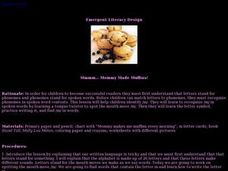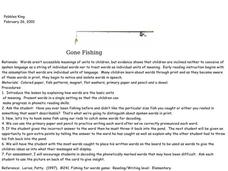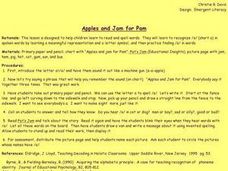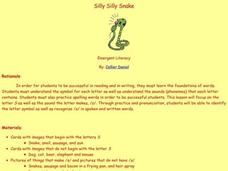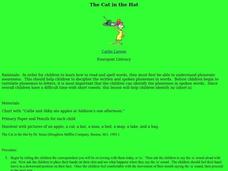Curated OER
"Mmmm... Yummy to My Tummy!"
Students answer a series of question about different letter sounds. They verbally practice the sounds of each letter following set responses. They write the different letters and find words that start with that letter.
Curated OER
O No!
First graders distinguish between short vowel a and long vowel O. They are introduced to the vowel-consonant-e pattern that changes short vowel sounds into long vowel sounds. They practice spelling words with the vowel-consonant-e pattern.
Curated OER
Mmmm...Mommy Made Muffins!
Students explore phonemes. They explore phonemes in spoken word contexts. Students discuss the phoneme /m/. They learn a tongue twister to help them recognize /m/. Students read "Stand Tall, Molly Lou Melon and identify the phoneme /m/...
Curated OER
Open Wide at the Dentist, "Aaaahh"
Study the /o/ in both written and spoken words by reciting a tongue twister and making words using Elkonin letterboxes. Next, write a message about frogs using /o/ words. Finally, listen to a short book talk on "Doc in the Fog" before...
Curated OER
Shhh
Students identify the digraph /sh/ in written and spoken language. Students practice the production of the /sh/ sound through storiesand tongue twisters. They identify the initial and final placement of the new digraph /sh/ using a...
Curated OER
Duh!
Students practice discerning between the letters and sounds for the lower case letters b and d. Through practice activities, they recognize the difference between the commonly confused letters b and d. They practice writing both letters...
Curated OER
Chocolate Chicken
Students identify digraphs in written and spoken language. After a brief discussion on the combinations of letters that comprise digraphs, students practice identifying initial and final placement of the digraph /ch/ in words and tongue...
Curated OER
Gone Fishing
Young scholars practice decoding words phonetically. The teacher discusses the association between spoken and written language. After the discussion, each student is given a word that is spelled phonetically. They decode the word by...
Curated OER
Aaaa! The Baby is Crying!
Students discover the correlation between graphemes and phonemes. They distinguish phonemes in verbal word contexts and match the letters to the phonemes. They focus on working to recognize the phoneme /a/ in its oral and written form.
Curated OER
Alphabetic Acting
Students recognize the short vowel a in written and spoken language. Through matching activities, they discriminate the short vowel /a/ from other vowel phonemes. Students associate the phoneme with its letter representation and identify...
Curated OER
Ah Ah Ah! Don't Do That!
Young scholars become familiar with the alphabetic principle that letters stand for phonemes and spellings map out the phonemes in spoken words. They focus on identifying the short /o/ sound in spoken words and the tongue twister "Oscar...
Curated OER
Pooh's Rumbling Tummy
Students recognize the short vowel u in written and spoken language. Through matching and listening activities, they discriminate the vowel sound /u/ from other phonemes. Students identify the phoneme and letter in words and pictures.
Curated OER
The Whining Child
Students recognize the short vowel u in written and spoken language. Through matching and listening activities, they discriminate the vowel sound /u/ from other phonemes. Students identify the phoneme and letter in words and pictures.
Curated OER
Tricky T
Students practice the corresponding phonemes associated with the letter and sound symbol to T. They identify the letter, write it and also identify pictures that display it's beginning sound. Students also interact with the book,...
Curated OER
Ehhh! Can you repeat that!
Students assess how to recognize phonemes that stand for letters creating spoken words utilizing the short vowel /e/. They associate our written language as a secret code to solve. The tongue twister "Everybody saw Eddie and the Eskimo...
Curated OER
Tricky Nicky
Students recognize the short vowel i in written and spoken language. Through listening and matching activities, they discriminate the vowel sound /i/ from other phonemes. Students identify the phoneme and letter in words they decode with...
Curated OER
Sticky Ricky!
Pupils explore letters and phonemes. They identify the short vowel i in spoken and written words. Students discuss a meaningful representation for the sound. They practice reading and spelling words with the i sound. Pupils read "Tin Man...
Curated OER
Apples and Jam for Pam
Students study the /a/ phoneme in written and spoken words by making the sound and identifying it in words. They repeat a phrase three times and write lower case a's on primary paper. Next, they listen to "Pat's Jam" and blink their eyes...
Curated OER
Crying Baby Sound
Students recognize the short vowel a in written and spoken language. Through matching and listening activities, they discriminate the vowel sound /a/ from other phonemes. Students identify the phoneme and letter in words from the story...
Curated OER
Emergent Literacy
Students practice speaking and spelling words, and recognize and demonstrate understanding of sounds (phonemes) that each letter contains. Students focus specifically on letter S and its sound.
Curated OER
The Cat in the Hat
First graders participate in an emergent literacy lesson to gain skills essential for the beginning reader. They practice the phoneme of the day or letter "A". The sound and recognition of the letter is the focus of the lesson.
Curated OER
The Pink Pig Gets Icky Sticky
Young scholars recognize that the letter "i" alone in written text will map out the /i/ phoneme in spoken words. By helping them with this short vowel mapping knowledge is further increased and decoding skills improve.
Curated OER
Ta-Ta- Timer
Students identify a letter of the alphabet. They recognize this letter in print and in spoken language. The letter and phoneme chosen is the letter t and /t/. They write the letter in both lower and upper case. They read 'One Tiny...
Curated OER
A Tisket-A-Tasket, Let?s Make a Flower Basket!!!
First graders practice blending words with the phonemes /i/ and /e/. Working with a specific groups of letters, 1st graders create words using the vowels i and e. they decode those words and read them repeatedly to increase fluency.




